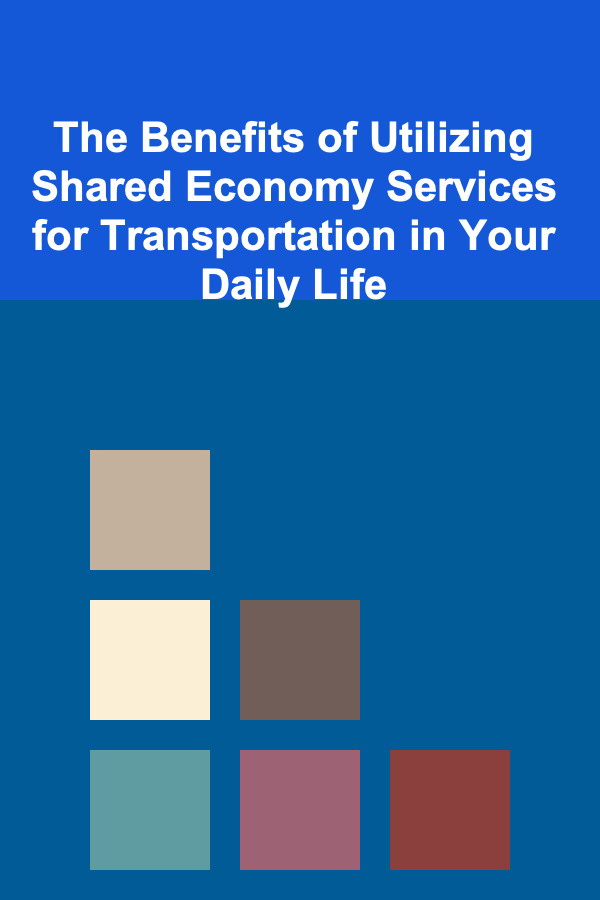
The Benefits of Utilizing Shared Economy Services for Transportation in Your Daily Life
ebook include PDF & Audio bundle (Micro Guide)
$12.99$10.99
Limited Time Offer! Order within the next:

In recent years, the rise of the shared economy (or "sharing economy") has transformed how we live, work, and interact with one another. Shared economy services, particularly those focused on transportation, have become an essential part of urban life. Whether it's through car-sharing platforms, bike-sharing systems, or ride-hailing services like Uber or Lyft, the transportation landscape has been fundamentally altered.
This article delves into the benefits of utilizing shared economy services for transportation and how incorporating them into your daily life can lead to savings, convenience, sustainability, and even social and community benefits.
Cost-Effectiveness
One of the most significant benefits of shared economy services for transportation is the potential for substantial cost savings. Traditionally, owning a car comes with considerable expenses, including car payments, fuel, insurance, parking fees, and maintenance. With shared economy transportation services, you only pay for what you use, which can be far more economical, especially for people who do not need a car on a daily basis.
Pay Only When You Need It
Using services like Uber, Lyft, or Zipcar means that you only incur costs when you actually need the service. There are no ongoing costs like car ownership, such as monthly payments or insurance premiums, which can add up quickly.
Additionally, if you opt for bike-sharing or car-sharing programs, the price is often lower than a traditional taxi or ride-hailing service. You can avoid paying for maintenance and other hidden costs associated with car ownership.
Reduced Need for Parking
Parking can be a significant financial burden in urban areas. Shared transportation services can eliminate the need to search for a parking spot or pay expensive parking fees. Some services also provide designated parking spots for vehicles, which further reduces the hassle.
Convenience and Accessibility
Shared economy services provide incredible flexibility and convenience. You can access a variety of transportation options at the touch of a button, and you don't need to worry about the complexities of vehicle ownership.
On-Demand Availability
Ride-hailing services like Uber and Lyft are available at any time of day or night. Whether you're commuting to work, running errands, or heading out for a night on the town, you can easily find a ride whenever you need it.
No Maintenance or Upkeep Required
Unlike owning a car, with shared transportation services, you don't have to worry about maintenance, cleaning, or ensuring the vehicle is in working condition. The service provider takes care of these aspects, allowing you to enjoy a hassle-free experience.
Easy Accessibility for All
For individuals who may not be able to drive, whether due to age, disability, or other factors, shared economy transportation offers an accessible alternative to traditional public transport or driving. Services like Lyft and Uber have even introduced specific programs designed to cater to riders with mobility challenges, making it easier for everyone to get around.
Environmental Impact and Sustainability
The environmental benefits of shared economy services are becoming increasingly important as climate change becomes a more pressing global issue. By utilizing these services, you can reduce your carbon footprint and contribute to a more sustainable future.
Fewer Cars on the Road
One of the key principles of the shared economy is reducing the number of vehicles on the road by encouraging people to share rides or use more efficient forms of transportation. Ride-sharing, carpooling, and bike-sharing systems help reduce traffic congestion and lower overall emissions by decreasing the number of individual cars in use.
Promoting Sustainable Transport Options
Many shared economy transportation services are embracing environmentally friendly practices. For example, bike-sharing programs encourage cycling, a low-emission form of transportation that's good for your health and the environment. Some ride-hailing services also offer electric vehicles (EVs) as part of their fleets, further reducing the impact of transportation on the environment.
Carpooling and Ride-Sharing
Services that offer carpooling, such as Lyft Line or UberPOOL, allow multiple riders to share a ride in the same vehicle, reducing the total number of cars on the road and cutting down on fuel consumption. This makes ride-hailing a more sustainable choice compared to driving alone.
Flexibility and Variety of Transportation Options
The shared economy offers a variety of transportation methods, which can be customized to meet your specific needs. Whether you need a quick ride, a larger vehicle for a group, or an eco-friendly option, there's something for everyone.
Diverse Options for Different Needs
Whether you need a bicycle for a quick trip across town, a car for a longer journey, or a ride-sharing service for a night out, the shared economy offers flexibility. Some services, like Lime and Bird, offer electric scooters and bikes, ideal for short trips. For longer trips, services like Zipcar or Turo provide access to vehicles without the need for ownership.
Special Features for Groups and Families
Shared economy services also cater to families or groups who need larger vehicles. Services like UberXL or Lyft XL allow passengers to book larger cars or SUVs for bigger groups, making it easy for families to share a ride without the need for multiple cars.
Social and Community Benefits
Beyond the practical and environmental advantages, shared economy services also contribute to building stronger communities and fostering social interactions.
Strengthening Local Economies
Shared economy platforms enable individuals to become entrepreneurs by offering services like driving for Uber or renting out a vehicle on Turo. This can be especially beneficial for people in areas where traditional employment opportunities may be limited. The money generated from these services can stay within local communities, contributing to economic growth.
Building Connections and Social Interaction
Using shared economy transportation services, such as ride-hailing or carpooling, also opens up opportunities for social interactions. It's not uncommon to have conversations with drivers or fellow passengers, making the journey more engaging and fostering a sense of connection between people.
Accessibility to Services in Underserved Areas
In some cities or neighborhoods where public transportation options are limited, shared economy services offer a much-needed alternative. For people in suburban or rural areas, these services can improve accessibility to jobs, education, and healthcare services, helping to bridge gaps in public transportation infrastructure.
Increased Safety and Security
When using shared economy transportation services, safety and security are top priorities. Companies in this sector have invested heavily in technology and safety features to ensure a secure experience for both drivers and passengers.
Real-Time Tracking and Ratings Systems
Most ride-hailing services provide features like real-time tracking and ride ratings, ensuring that both drivers and passengers can be held accountable. If anything goes wrong during a ride, users can report issues, and the company can investigate.
Professional Drivers and Vehicle Inspections
With many shared transportation services, drivers are required to go through background checks, ensuring that you're riding with someone who is qualified and trustworthy. Additionally, vehicles are often inspected to ensure they meet safety standards.
Emergency Assistance Features
In case of an emergency, most shared transportation services have in-app features that allow passengers to quickly contact emergency services or the platform's support team. This added level of security provides peace of mind when using shared economy services.
Conclusion
The shared economy has brought about a fundamental shift in the way we approach transportation. By utilizing these services, individuals can save money, reduce their environmental footprint, enjoy a more convenient and flexible travel experience, and even benefit socially and economically. Whether you're looking to cut down on costs, explore sustainable travel options, or enjoy a more accessible and community-driven transportation system, shared economy services are a viable and impactful choice for your daily life. As the world continues to move toward more sustainable and shared solutions, embracing these services can help contribute to a better, more connected future.

How to Build Multiple Income Streams to Improve Financial Stability
Read More
How to Clean and Maintain Your Jewelry for Longevity
Read More
How to Create a Cozy Home Without Breaking the Bank
Read More
How to Have a Family DIY Home Improvement Project
Read More
How to Make Your Home More Accessible with Renovations
Read More
How to Master Slacklining for Balance and Focus
Read MoreOther Products

How to Build Multiple Income Streams to Improve Financial Stability
Read More
How to Clean and Maintain Your Jewelry for Longevity
Read More
How to Create a Cozy Home Without Breaking the Bank
Read More
How to Have a Family DIY Home Improvement Project
Read More
How to Make Your Home More Accessible with Renovations
Read More